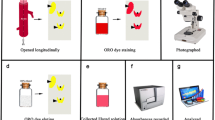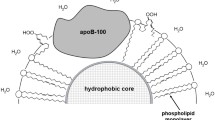Abstract
To evaluate the role of lipid oxidation in atherogenesis the levels of lipid- and protein-bound products of peroxidation in normal and atherosclerotic areas of human aorta were investigated. The level of fluorescent (360/430 nm) lipid products was measured in chloroform-methanol extracts of aortic tissue. Normal intima, initial lesions and fatty streaks had a similar content of fluorescent substances. On the other hand, high level of fluorescent products was found in atherosclerotic plaques. Cholesterol covalently bound to proteins, which serve as a marker of lipoperoxidation, was measured by high performance liquid chromatography after mild alkaline hydrolysis of delipidated tissue protein samples. The levels of protein-bound cholesterol in initial lesions and fatty streaks were close to its content in uninvolved intima (59 ± 18 and 92 ± 18 vs 70 ± 13 nmol/g protein). The content of covalently bound cholesterol in atherosclerotic plaques was dramatically higher (90-fold) than in the normal tissue. In addition to protein-bound cholesterol, considerable amount of lipofuscin was revealed in the cells of atherosclerotic plaques, but not in the cells of normal intima, initial lesions or fatty streaks. Thus, the contents of all investigated lipid- and protein-bound products of lipoperoxidation in earlier atherosclerotic lesions were similar to their levels in normal tissue. It can be due to a low rate of oxidized product formation and/or high rate of its degradation in or elimination from the vessel wall.
Similar content being viewed by others
References
Steinberg D, Parthasarathy S, Carew TE, Khoo J, Witztum J: Beyond cholesterol: Modifications of low density lipoprotein that increase its atherogenicity. N Engl J Med 320: 915–924, 1989
Witztum JL, Steinberg D: Role of oxidized low density lipoprotein in atherogenesis. J Clin Invest 88: 1785–1792, 1991
Esterbauer H, Gebicki J, Puhl H, Jurgens G: The role of lipid peroxidation and antioxidants in oxidative modification of LDL. Free Radic Biol Med 13: 341–390, 1992
Berliner JA, Heinecke JW: The role of oxidized lipoprotein in atherogenesis. Free Radic Biol Med 20: 707–727, 1996
Harland WA, Gilbert JD, Steel G, Brooks JW: Lipids in human atheroma. Part 5. The occurrence of a new group of polar sterol esters in various stages of human aorta. Atherosclerosis 13: 239–246, 1971
Carpenter KLH, Taylor SE, van der Veen C, Williamson BK, Ballantine JA, Mitchinson MJ: Lipids and oxidized lipids in human atherosclerotic lesions at different stages of development. Biochim Biophys Acta 1256: 141–150, 1995
Carpenter KLH, Taylor SE, van der Veen C, Mitchinson MJ: Evidence of lipid oxidation in pulmonary artery atherosclerosis. Atherosclerosis 118: 169–172, 1995
Kuhn H, Belker J, Wiesner R, Schewe T, Lankin VZ, Tikhaze AK: Structure elucidation of oxygenated lipids in human atherosclerotic lesions. Eicosanoids 5: 17–22, 1992
Folchic VA, Nivar-Aristy RA, Kraewski LP, Cathcart MK: Lipoxygenase contributes to the oxidation of lipids in human atherosclerotic plaques. J Clin Invest 96: 504–510, 1996
Leeuwenburgh C, Rasmussen JE, Hsu FF, Mueller DM, Pennathur S, Heinecke JW: Mass spectrometric quantification of markers for protein oxidation by tyrosys radical, cooper, and hydroxyl radical in low density lipoprotein isolated from human atherosclerotic plaques. J Biol Chem 272: 3520–3526, 1977
Hazell LJ, Arnold L, Flowers D, Waeg G, Malle E, Stocker R: Presence of hypochlorite-modified proteins in human atherosclerotic lesions. J Clin Invest 97: 1535–1544, 1996
Piotrowski JJ, Hunter GC, Eskelson CD, Dubick MA, Bernhard VM: Evidence for lipid peroxidation in atherosclerosis. Life Sci 46: 715–721, 1990
Palinski W, Rosenfeld ME, Yla-Herttuala S, Gurtner GC, Socher SS, Butler SW, Parthasarathy S, Carew TE, Steinberg D, Witztum JL: Low density lipoprotein undergoes oxidative modification in vivo. Proc Natl Acad Sci USA 86: 1372–1376, 1989
Jurgens G, Chen Q, Esterbauer H, Mair S, Ledinski G, Dinges HP: Immunostaining of human autopsy aortas with antibodies to modified apolipoprotein B and apolipoprotein(a). Arterioscler Thromb 13: 1689–1699, 1993
Salomon RG, Subbanagounder G, O'Neil J, Kaur K, Smith MA, Hoff HF, Perry G, Monnier VM: Levaulandin E2-protein adducts in human plasma and vasculature. Chem Res Toxicol 10: 536–545, 1995
Hoppe G, Ravandi A, Herrera D, Kuksis A, Hoff, HF: Oxidation products of cholesteryl linoleate are existent to hydrolysis in macrophages, form complexes with proteins, and are present in human atherosclerotic lesions. J Lipid Res 38: 1347–1360, 1977
Tertov VV, Kaplun VV, Dvoryantsev SN, Orekhov AN: Apolipoprotein B-bound lipids as a marker for evaluation of low density lipoprotein oxidation in vivo. Biochem Biophys Res Commun 214: 608–613, 1995
Ball RY, Carpenter KLH, Mitchinson MJ: What is the significance of ceroid in human atherosclerosis? Arch Pathol Lab Med 111: 1134–1140, 1987
Stary HC: Composition and classification of human atherosclerotic lesions. Virchows Arch A, Pathol Anat Histopathol 42: 277–290, 1992
Orekhov AN, Tertov VV, Novikov, ID, Krushinsky AV, Andreeva ER, Lankin VZ, Smirnov VN: Lipids in cells of atherosclerotic and uninvolved human aorta. I. Lipid composition of aortic tissue and enzyme isolated and cultured cells. Exp Mol Pathol. 42: 117–137, 1985
Bligh EJ, Dyer WJ: A rapid method of total lipid extraction and purification. Can J Biochem Physiol 37: 911–917, 1959
Lowry OH, Rosenbrough NJ, Farr AL, Randall RJ: Protein measurement with the Folin phenol reagent. J Biol Chem 193: 265–275, 1953
Dixon WJ, Brown MB: Biomedical Computer Programs. P-Series. University of California Press, Berkeley, CA, 1979, 185–198
Lankin VZ, Vikhert AM, Kosykh VA, Tikhaze AK, Galakhov IE, Orekhov AN, Repin VN: Enzymatic detoxication of superoxide anionradicals and lipoperoxides in intima and media of atherosclerotic aorta. Biomed Biochim Acta 43: 797–802, 1984
Mitchinson MJ, Hothersall DC, Brooks PN, De Burbure CY: The distribution of seroid in human atherosclerosis. J Pathol 145: 177–183, 1985
Shimasaki H, Maeba R, Tachibana R, Ueta N: Lipid peroxidation and ceroid accumulation in macrophages cultured with oxidized low density lipoprotein. Gerontology 41: 39–48, 1995
Orekhov AN, Tertov VV, Mukhin DN, Mikhailenko IA: Modification of low density lipoprotein by desialylation causes lipid accumulation in cultured cells. Discovery of desialylated lipoprotein with altered cellular metabolism in the blood of atherosclerotic patients. Biochem Biophys Res Commun 162: 206–211, 1989
Orekhov AN, Tertov VV, Mukhin DN: Desialylated low density lipoprotein - naturally occurring modified lipoprotein with atherogenic potency. Atherosclerosis 86: 153–161, 1991
Krauss RM, Burke DJ: Identification of multiple subclasses of plasma low density lipoproteins in normal humans. J Lipid Res 23: 97–104, 1982
Avogaro P, Bittolo Bon G, Cazzolato G: Presence of a modified low density lipoprotein in humans. Arteriosclerosis 8: 79–87, 1988
Tertov VV, Sobenin IA, Orekhov AN: Similarity between naturally occurring modified desialylated, electronegative and aortic low density lipoprotein. Free Radic Res 25: 313–319, 1996
Tertov VV, Bittolo-Bon G, Sobenin IA, Cazzolato G, Orekhov AN, Avogaro P: Naturally occurring modified low density lipoproteins are similar if not identical: More electronegative and desialylated lipoprotein subfractions. Exp Mol Pathol 62: 166–172, 1995
Tertov VV, Sobenin IA, Gabbasov ZA, Popov EG, Jaakkola O, Solakivi T, Nikkari T, Smirnov VN, Orekhov AN: Multiple-modified desialylated low density lipoproteins that cause intracellular lipid accumulation: Isolation, fractionation and characterization. Lab Invest 67: 665–675, 1992
Tertov VV, Kaplun VV, Orekhov AN: In vivo oxidized low density lipoprotein: Degree of lipoprotein oxidation does not correlate with its atherogenic properties. Mol Cell Biochem 183: 141–146, 1998
Camejo G, Lopez A, Lopez F, Quinones J: Interaction of low density lipoprotein with arterial proteoglycans: The role and charge of sialic acid content. Atherosclerosis 55: 93–105, 1985
Anber V, Millar JS, McConnell M, Shepherd J, Packard CJ: Interaction of very-low-density, intermediate-density, and low-density lipoproteins with human arterial wall proteoglycans. Arterioscler Thromb Vasc Biol 17: 2507–2514, 1997
Tertov VV, Sobenin IA, Kaplun VV, Orekhov AN: Antioxidant content in low density lipoprotein and lipoprotein oxidation in vivo and in vitro. Free Radic Res 29: 165–173, 1998
Author information
Authors and Affiliations
Corresponding author
Rights and permissions
About this article
Cite this article
Tertov, V.V., Kaplun, V., Mikhailova, I. et al. The content of lipoperoxidation products in normal and atherosclerotic human aorta. Mol Cell Biochem 225, 21–28 (2001). https://doi.org/10.1023/A:1012267520932
Issue Date:
DOI: https://doi.org/10.1023/A:1012267520932




